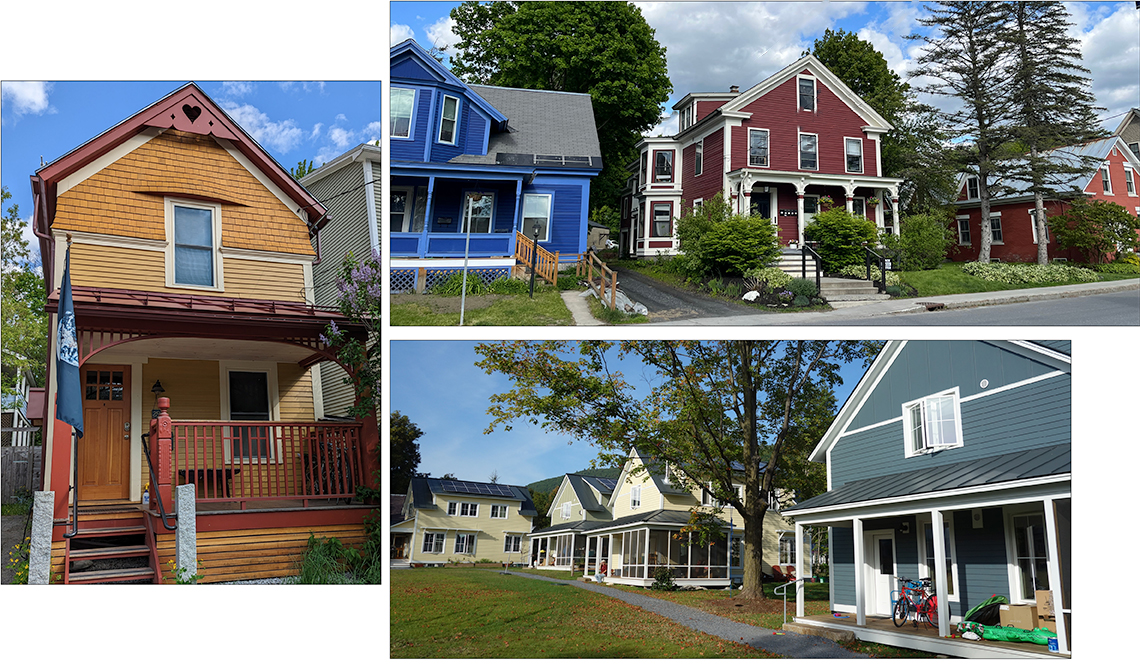
- Select a language for the TTS:
- UK English Female
- UK English Male
- US English Female
- US English Male
- Australian Female
- Australian Male
- Language selected: (auto detect) - EN
Play all audios:
In early June 2023, a month before Vermont and its state capital of Montpelier became overwhelmed by heavy rains and flash flooding, Governor Phil Scott signed the HOUSING OPPORTUNITIES MADE
FOR EVERYONE (OR HOME) ACT, a bill that will help communities throughout the state expand housing availability, affordability and housing-type options. FREE GUIDE ABOUT ZONING Click on the
image to learn about this 24-page photo- and information-filled publication and how to get it. AARP.org/Zoning VERMONT’S HOUSING REFORM LAW WAS KICKSTARTED BY WORK THE STATE ENGAGED IN WITH
THE CONGRESS FOR THE NEW URBANISM. LEARN ABOUT THE COLLABORATION AND THE BENEFITS OF IMPLEMENTING INCREMENTAL, TARGETED ZONING CODE CHANGES BY ORDERING OR DOWNLOADING _ENABLING BETTER
PLACES: A HANDBOOK FOR IMPROVED NEIGHBORHOODS_, A FREE PUBLICATION BY AARP AND CNU. The new rules, which will be fully implemented by December 2024, are a key ingredient for meeting
Vermont’s dire need for increased and updated housing, and especially housing that is affordable and suitable for both young and much older adults. With 20.6 percent of the state’s
population currently age 65 or older, Vermont is the nation’s third oldest state after Maine (21.8 percent) and Florida (20.6 percent). Rental housing prices can be very high, especially in
locations such as the ski communities, where young workers are needed. (A one-bedroom apartment in Stowe, for instance, rents for $1,900 a month.) By changing outdated state and local zoning
codes to be more aligned with 21st century realities, the legislation acknowledges that the Vermont’s longstanding zoning regulations, land use policies and lengthy permitting processes
haven’t been meeting the needs of residents. “This bill creates opportunities to create new and more dense housing in the places we want it, rehab previously offline units, and reform our
land and zoning laws, all of which will begin to address this housing crisis,” said Josh Hanford, commissioner of the Vermont Department of Housing and Community Development. The HOME Act
opens doors to more housing production by focusing growth on areas where development already exists and makes sense, such as by allowing for higher density development in areas that are
already equipped with sewer and municipal water service. (Rural regions that are dependent upon septic and well water systems are not suitable for increased housing and development.) AMONG
THE HOUSING ISSUES ADDRESSED BY THE LEGISLATION: PROBLEM: _Large lot-size minimums (such as zoning codes that call for at least one-acre per single-family home) prevent the development of
walkable, sustainable, all-incomes neighborhoods that can alleviate a housing shortage and jumpstart a local economy._ SOLUTION: The HOME Act requires five or more units per acre in areas
served by water and sewer. Smaller homes better meet the needs of downsizing older adults and newly launching young adults. PROBLEM: _Zoning codes that require an excessive amount of
parking perpetuate sprawl, necessitate auto-oriented (and emission-heavy) transportation systems, and use land that could be used for housing._ SOLUTION: Since housing can be built in a way
that is more conducive to safe walkability, the HOME Act reduces parking minimums to one-space per dwelling unit. PROBLEM: _Prior to the creation of zoning codes in the early 20th century,
Vermont communities consisted of many different housing types on varying lot sizes, which enabled compact, walkable communities. Subsequent size mandates and limits on allowable uses have
curtailed housing solutions such as mixed-use residential buildings and neighborhoods where homes and businesses can coexist._ THE HOME ACT * "Vermont Housing Bill Becomes Law Easing
Rules for Some New Construction Amid Home Shortage" (Vermont Public Radio) * "Governor Phil Scott Signs S-100 Housing Bill Bringing Regulatory Reforms" (Vermont.gov) SOLUTION:
The HOME Act allows for the creation of duplex properties anywhere single-family homes are allowed and multiunit dwelling of up to four units in areas served by sewer and water. The
legislation also allows for the development of up to 25 units in designated downtowns and villages, and it provides millions of dollars in subsidies to build more housing (including rental
units) in areas located near schools, jobs, stores and recreation. In order to keep development in check, many of the new provisions will expire in 2026. The measures add up to enable
smaller, denser, Missing Middle-style homes and accessory dwelling units (or ADUs) that can make it easier for older Vermonters to downsize in walkable communities and live independently
near friends and neighbors. By pursuing zoning reform as an avenue to greater housing affordability — and more livable, walkable communities — Vermont joins states including Oregon,
California, Virginia and Washington. “Vermont’s tri-partisan legislation showcases what makes Vermont unique,” writes Amy Love Tomasso, planning coordinator for the Vermont Department of
Housing and Community Development, in an article for the website Public Square. “As a pro-property and municipal rights state, Vermont is still a place where folks across the aisle can build
bridges for the common good and are able to shift longstanding policy to be more equitable.” _KELLY STODDARD POOR is an associate state director of AARP VERMONT_ MORE ABOUT ZONING AND
HOUSING _Page published August 2023_







